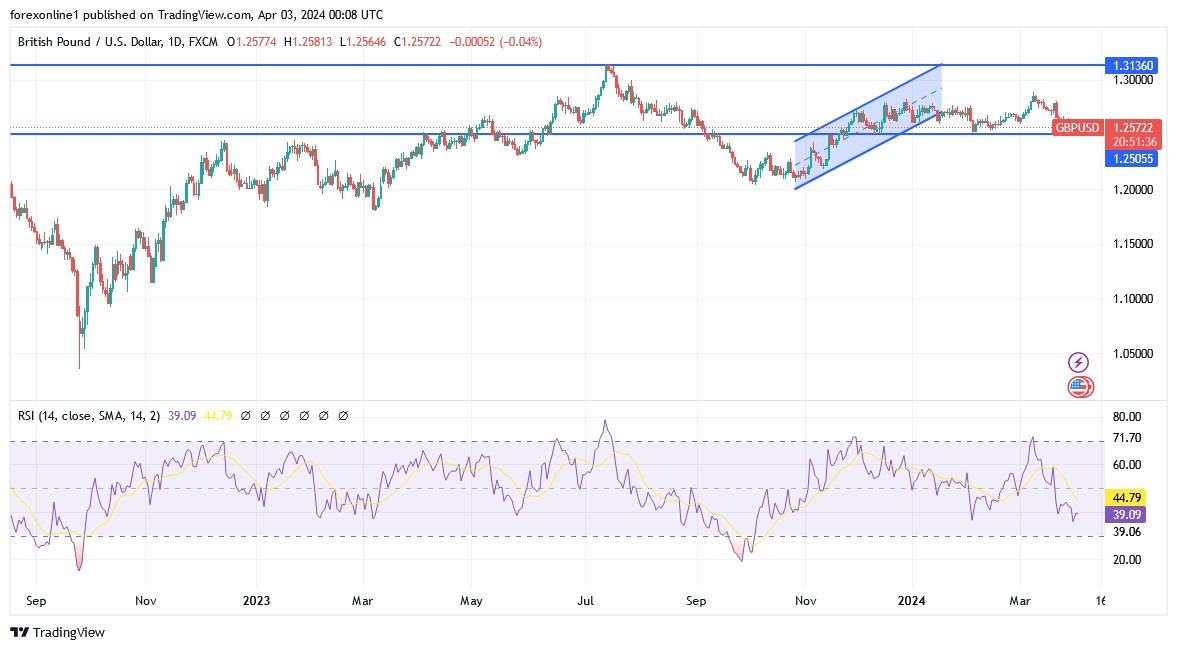- Finally, hopes of the GBP/USD currency pair moving towards the psychological resistance level of 1.3000 in the near term have evaporated.
- The US dollar is witnessing an increase, supported by US economic data that have surpassed consensus, indicating that the Federal Reserve is likely to cut interest rates after the Bank of England and the European Central Bank.

According to forex trading platforms, the pound sterling exchange rate against the dollar (GBP/USD) dropped to support at 1.2540, the lowest level since February, after the US Manufacturing Purchasing Managers' Index (PMI) rose to a reading of 50.3 in March from 47.8 in February, comfortably exceeding expectations of 48.4. Also, the report indicated that inflationary pressures facing US companies are increasing again, with the prices paid component in the report rising to 55.8, surpassing estimates of 52.6.
Overall, market expectations for a rate cut by the US Federal Reserve in June have decreased after the release of the data, which boosted US yields and the dollar. The US dollar was further bolstered by the strong ISM index, according to Ulrich Leuchtmann, Head of FX, and Commodity Research at Commerzbank. He stated, "Strong growth in the United States may allow the Federal Reserve to maintain its federal funds rate at its current elevated level for longer than previously assumed by the market."
Meanwhile, this development reinforces the growing downtrend in the GBP/USD exchange rate, which has now fallen below the 50-week moving average. The performance on the chart above shows that the 50-week moving average provided support for the pound, and we are now seeing that a long-term downtrend may be forming. However, daily support is at February lows near 1.2517, a level we are watching this week.
In general, the upside trend for the GBP/USD pair in the near term will be determined by the 100-day moving average, which is currently located at 1.2652, which has limited the upside potential for the pound since March 22.
Top Forex Brokers
According to analysts, amid strong US data at the start of the week, the pound broke below some key moving averages against the US dollar in a bearish move that suggests the possibility of a deeper decline in GBP/USD in the short term. Recently, the pair has fallen by about 3% from its 7-month high hit in early March and is nearing a test of its 2024 low near $1.25 support. Thus, hopes of trading at $1.30 this spring are quickly fading.
Looking at the economic calendar this week, the ISM services PMI, job openings and the US non-farm payrolls report will be closely watched, as will comments from a number of Fed officials. It is worth noting that April is usually a good month for the pound, and analysts say the currency could rise against the euro and the dollar. April is ranked among the best months of the year for the pound thanks to companies repatriating foreign currency to pay dividends. The average monthly gain over the past ten years in April has been 0.8%. Ultimately, the standard deviation is 2.2%.
GBPUSD Expectations and Analysis Today:
According to analysts at Bank of America, “April is the right place for the pound.” If history is any guide, the GBP/USD $1.30 price is likely to be tested. However, past performance is by no means a firm guide to future developments, and there is a risk that April 2024 will be a down month due to the buoyant US economy and increased odds that the Bank of England will cut interest rates before the Fed does.
Ready to trade our daily Forex analysis? We’ve made this UK forex brokers list for you to check out.
